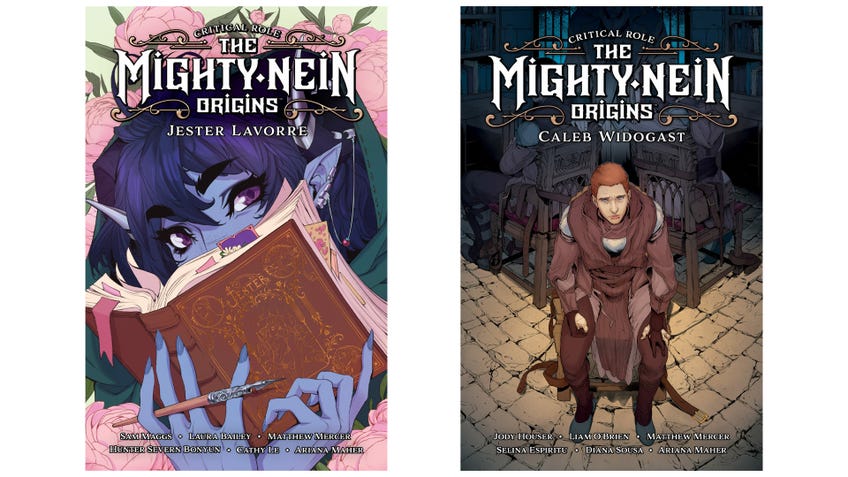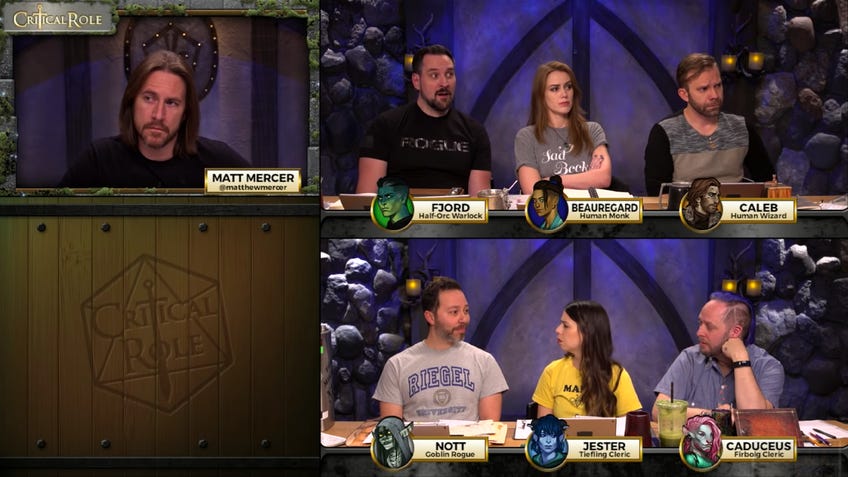Critical Role’s Campaign 2 finale shows just how far the hit Dungeons & Dragons series has come
Forever throwing fluffernutters.
I started watching Critical Role in the summer of 2016, during a time in my life when I was desperate for some escapism. Having graduated the year before, I was struggling to find positivity amongst the disappointment of post-university life and the directionless path I had found myself meandering along. My friend recommended I give Critical Role a try, after learning that I enjoyed playing tabletop RPGs. It’s safe to say that I jumped onto the Critical Role wagon pretty quickly after that.
Despite never being a huge fan of Dungeons & Dragons, watching a cast of charismatic and talented actors roleplaying with an excellent dungeon master was immediately compelling. Considering how uninspiring my life was at the time, it was easy to get sucked into the world created by Matthew Mercer, alongside the characters portrayed by the likes of Ashley Johnson, Travis Willingham, Laura Bailey and Liam O’ Brian.
After finishing the first campaign, following the Vox Machina party, I - like many others - eagerly awaited the second.
What I noticed straight away about Campaign 2, when compared with the first, was the way in which the actors had approached their characters. Vox Machina were a lovable bunch of recognisable RPG tropes - for example, the benevolent cleric Pike, mysterious rogue Vax and himbo barbarian Grog. They felt like the kind of characters you’d expect to see in a pretty bog-standard D&D story, who had been elevated above cliche thanks to the talents of the actors portraying them.
The Mighty Nein, on the other hand, weren’t heroes. These were losers, loners and social outcasts.
The characters created for Campaign 2 had something undeniably different about them. Not only were several of them of species that are typically less commonly played in D&D - such as tieflings, half-orcs and even a goblin - but they had personalities that decidedly did not fit the common makings of a hero. Vox Machina undoubtedly had a little growing to do in order to fit into the quintessential shoes of a hero, but the blueprints were definitely there. The Mighty Nein, on the other hand, weren’t heroes.
These were losers, loners and social outcasts.
Of course, this only made their eventual transformation into adventurers, fighters and dreamers all the more special to watch. Instead of fulfilling a destiny, the Mighty Nein were vehemently defying the path that had been laid out for them by society and people’s expectations. Throughout the course of Campaign 2 a warlock broke free of his manipulative patron, a monk proved to her neglectful father that she didn’t need his approval to achieve great things, and a wizard turned his back on the person who had made him hate himself in favour of self-love. All of these character arcs depicted people who had suffered at the hands of those who had abused a position of power, thereby reclaiming themselves.

Choosing to focus on the wrongdoings of specific organisations and systems, more than the sins of any individual, made the plotlines of Critical Role’s second season so much more engaging. The characters navigated a full-scale cultural and military war, investigating government-supported organisations and taking down manipulative cults. The narratives of Campaign 2 continuously reinforced the fact that the majority of the problems faced by the members of the Mighty Nein and the people they encountered in their journeys were caused by corrupted systems being neglectful, driven by fear or unwilling to face the human cost of their actions.
There were high stakes to this story - with some major characters experiencing great loss along the way - which meant that I only cared about the cast even more.

The romantic relationships and deep friendships in the second campaign were so carefully fleshed out and bloomed so naturally between characters that they were easier to root for.
My emotional investment in Campaign 2 was only intensified by the fact that the relationships between the cast members and non-player characters felt so meaningful. Though there were plenty of memorable characters and relationships in the first season, some of them still had an aura of incompleteness about them - more like the kind of last-minute heartful conversation or sex scene you might experience in a video game. Whereas the romantic relationships and deep friendships in the second campaign were so carefully fleshed out and bloomed so naturally between characters that they were easier to root for.
It certainly helped that there was a lot more LGBTQ+ representation amongst the characters this time. Though there were queer characters in Campaign 1, it just didn’t feel like a lot of time was devoted to their growth. The Mighty Nein included two gay women, an aromantic and asexual character, and a genderfluid individual, alongside several Queer non-player characters. At no point did it feel like these were token additions to shoehorn representation in, either. These elements were wholly part of the characters’ identities and depicted in such a natural way - helped by many hours the players and audience spent with the characters - that it was a wonderful thing to see.
When I consider the fact that Critical Role Campaign 2, which has been such a frequent part of my life for the past few years, is over, I’m kind of overwhelmed. Even though Critical Role will keep going - they’ve already announced a spin-off series and Campaign 3 is all but confirmed - my time with the Mighty Nien is over, for now. These characters - who captained their own ship, gave each other tattoos, had a drunken party on a remote island and regularly teleported uninvited into the headquarters of an important organisation - have been left to their own fictional devices.
Campaign 2 wasn’t afraid to embrace the themes of death, grief, regret and hardship. But it always did so whilst clutching onto the possibility of hope. Which is why I can’t wait to see what else Critical Role has in store.











